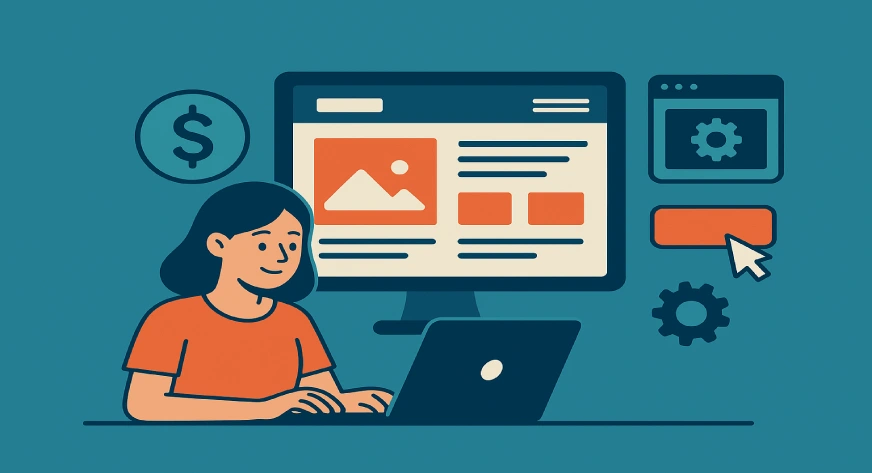Where To Find Affordable Web Design for Small Business?

You can find affordable web design resources for small businesses on platforms like Canva, Wix, ThemeForest, Envato Elements, Fiverr, Upwork, WebWorks Co. and Creative Market. These sites offer budget-friendly templates, design tools, and freelancers to create professional websites without high costs.
For small businesses, building a website can feel like an expensive task. But it doesn’t have to be. With the right tools, resources, and planning, affordable web design for small business is completely achievable. Whether you’re just starting out or looking to revamp an old site, there are plenty of budget-friendly options that give you a professional look without overspending.
DIY Design Tools
One of the fastest and cheapest ways to create a website is through DIY website builders. They’re beginner-friendly, don’t require coding, and often come with ready-to-use features.
Popular options
- Wix – Easy drag-and-drop, ideal for service-based businesses.
- Squarespace – Sleek designs, perfect for creative portfolios.
- Shopify – Best for small e-commerce stores.
Example: A local bakery can use Shopify to upload products, manage payments, and display their menu—all with minimal technical effort.
Free and Paid Templates
If you want your site to look professional without hiring a designer, templates are a great shortcut. They give you a solid base, which you can then customize to fit your brand.
- Free Templates: Found on WordPress, Webflow, and community platforms like Dribbble.
- Paid Templates: Usually cost between $30–$150 and come with better layouts, customer support, and extra features.
- Best for: Businesses like fitness coaches, photographers, or consultants who want fast setup with minimal cost.
Example: A fitness trainer could buy a $70 template with built-in booking forms, instead of paying $1,000+ for custom coding.
Also Read, How To Use Figma for Web Design?
Affordable Freelancers
When DIY tools or templates feel too generic, freelancers can give you a more customized design—still at a fraction of agency costs.
Where to find them:
- Fiverr – Quick, affordable gigs (starting from $50).
- Upwork – Ideal for long-term or complex projects.
- Freelancer.com – Good mix of skill levels and pricing.
Tips before hiring:
- Always check reviews and portfolios.
- Ask for sample mockups if possible.
- Clarify timelines and revisions before paying.
Example: A local clothing brand could work with a freelancer to design a Shopify store that reflects its unique style, for $500–$800 instead of thousands.
Open-Source Resources
For businesses that have someone a bit tech-savvy in the team, open-source resources can save serious money.
Useful resources include:
- Bootstrap & Tailwind CSS – Free frameworks to build responsive layouts.
- Google Fonts – High-quality typography for free.
- FontAwesome – Free icons for menus and buttons.
- Unsplash & Pexels – Stock images without licensing fees.
Example: A startup founder can use Bootstrap for design, Google Fonts for style, and Unsplash images—creating a polished look with zero cost on design assets.
Online Communities and Forums
Sometimes the best resources come from people sharing their knowledge. Online communities often post free templates, design assets, and troubleshooting advice.
Where to look:
- Reddit (r/web_design) – Free advice and resources.
- IndieHackers – Useful for startups building from scratch.
- Dribbble freebies – Free icons, templates, and illustrations.
Example: A café owner can find a free menu template on Dribbble and adapt it instead of hiring a designer for the same task.
Quick Tips to Save Money Without Sacrificing Quality
When working on a budget, it’s tempting to cut corners—but that often leads to a website that looks cheap or doesn’t perform well. The good news? You don’t have to spend a fortune to get a site that works. Here are some practical ways to save money while still building a site that feels professional:
Start with the basics only
Focus on the must-have pages like Home, About, Services/Products, and Contact. This helps you launch faster and avoid paying for features you don’t need yet. You can always add a blog, shop, or booking system later when your budget allows.
Take advantage of free trials
Many website builders, plugins, and tools offer free trials. Use this time to test them out and see if they’re worth paying for. This way, you only invest in tools that genuinely add value to your business.
Use free resources smartly
Stock photo platforms like Unsplash or Pexels, free icons from FontAwesome, or free fonts from Google Fonts can make your website look polished without extra costs. Pairing these with a low-cost template can instantly improve your design.
Hire freelancers for the tricky parts
Instead of outsourcing the whole project, handle simple edits yourself and hire freelancers only for the tasks you can’t manage, like custom coding or logo design. This way, you get expertise without overspending.
Also Read, How to Choose the Best Webflow Template?
Learn a little DIY editing
Most builders like WordPress, Wix, or Squarespace make it easy to update text, swap images, or adjust colors. Learning these basics means you won’t need to pay a designer every time you want a small change.
Final Thoughts
Affordable web design for small business is less about cutting corners and more about using smart choices. Whether you use DIY builders, ready-made templates, freelancers, or open-source tools, the goal is to create a site that works well and represents your brand. With a little planning, even small businesses can have websites that look professional without draining their budget.
If you’re exploring long-term support for web design and digital growth, Cheval-Rise by WebWorks Co. offers flexible solutions that balance affordability with quality, ideal for businesses that want both functionality and style without unnecessary costs.
